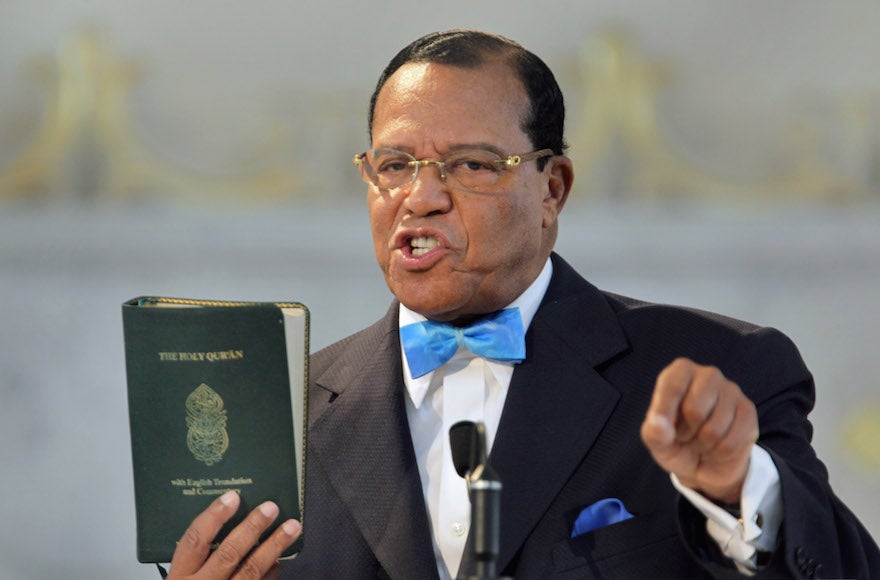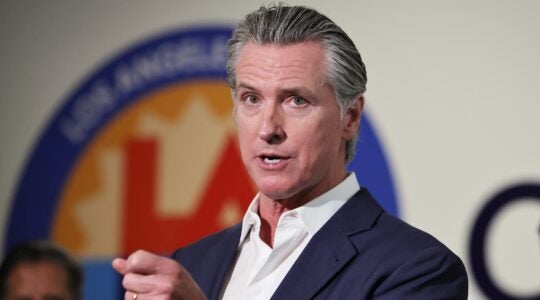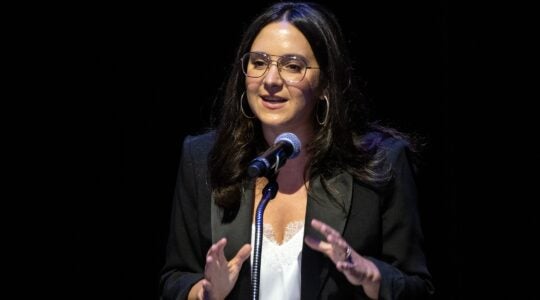(JTA) — Louis Farrakhan was an anti-Semite in 1972 when he said Jews were “in control of the media.”
He was an anti-Semite in 1984 when he said “Hitler was a very great man.”
He was an anti-Semite in 1995 when he said “You are the synagogue of Satan, and you have wrapped your tentacles around the U.S. government, and you are deceiving and sending this nation to hell.”
He was an anti-Semite — and homophobe — in 2007 when he said “It’s the wicked Jews, the false Jews that are promoting lesbianism, homosexuality.”
And he was an anti-Semite again last Sunday at an annual gathering of the Nation of Islam when he said he “has pulled the cover off the eyes of that Satanic Jew and I’m here to say your time is up, your world is through.”
“He was always very anti-Semitic and he remains very anti-Semitic,” said Oren Segal, director of the Anti-Defamation League’s Center on Extremism. “The one thing that has remained consistent is the anti-Semitism that has come from his speech.”
The 84-year-old leader of the Nation of Islam, a black separatist movement, made headlines again this week when he gave a speech to thousands laced with anti-Semitic conspiracy theories.
But what’s drawing scrutiny is why Farrakhan, after years of denunciations by groups like the ADL and the Southern Poverty Law Center — and by politicians, including African-Americans who once may have considered him an ally — is still accepted by mainstream public figures.
Several leading liberals have drawn fire in recent weeks for their associations with Farrakhan. Most prominent was former President Barack Obama, who appeared in a newly uncovered photo smiling next to Farrakhan at a meeting of the Congressional Black Caucus in 2005. The circumstances of the photo remain unclear, but the photographer said he sat on it for years because allies of Obama feared its publication would have sunk the presidential ambitions of the up-and-coming senator. Others wanted to know why the CBC was still welcoming Farrakhan to one of its events.
Obama has criticized Farrakhan’s anti-Semitism and disavowed his support during his 2008 campaign for the Democratic presidential nomination. After the photo emerged, his camp referred reporters to those denunciations.
Asked about the photo by the conservative Daily Caller, Illinois Democratic Rep. Danny Davis was quoted calling Farrakhan “an outstanding human being” who “plays a big role in the lives of thousands” of people — though Davis insists he was misquoted. Davis’ office said he would have no further comment.
Rep. Keith Ellison, D-Minn., the second in charge at the Democratic National Committee, has been dogged by his associations with Farrakhan, which lasted until at least the late 1990s. Running for Congress for the first time in 2006, he wrote a letter to Minnesota’s Jewish community disavowing Farrakhan and his anti-Semitism.
But last month he was criticized for attending a 2013 dinner hosted by the Iranian government whose guests included Farrakhan. Ellison, who is Muslim, said he attended the dinner with other Muslims “to advocate for a peaceful resolution to the Iranian nuclear issue” and didn’t know in advance who else would be there.
One of Farrakhan’s unapologetic supporters is Tamika Mallory, a co-organizer of the Women’s March, who has praised Farrakhan repeatedly, posted a photo of her posing with him on Instagram and attended Sunday’s speech. Mallory did not respond immediately to a JTA request for comment.
CNN anchor Jake Tapper called out Mallory, along with other high-profile supporters of Farrakhan, in a tweet thread about the speech.
“The difference between Farrakhan and some members of the alt-reich whose heinous bigotry has received a lot of attention this past year: Farrakhan has a much larger following and elected officials meet with him openly,” Tapper wrote.
But how broad is Farrakhan’s influence nowadays? Two decades ago, his Million Man March, which brought hundreds of thousands of black men to Washington, D.C., in a demand for racial justice and empowerment, put him squarely at the center of public discourse. Now his events draw thousands. Farrakhan’s 2015 demonstration marking the 20th anniversary of the Million Man March was much smaller.
Nor is Farrakhan much of a power broker in his home base of Chicago, says Jay Tcath, executive vice president of the Jewish United Fund, the city’s Jewish federation. Tcath says that while local African-American leaders may not be eager to publicly denounce him, Chicago’s Jewish institutions don’t see his hate as a major, or growing, threat.
“He has not grown the movement, he has not graduated to a larger venue, he has no public policy agenda, the number of mosques under his domain are not increasing,” Tcath told JTA. “That’s not to diminish his bigotry, but it’s to recognize that of the many challenges our community faces, including anti-Semitism, his brand is not contagious among many others.”
Segal said that the fact that Farrakhan still draws thousands makes him the most popular purveyor of hate in America — more influential than Richard Spencer or other white supremacists. Their much-publicized Unite the Right rally last August in Charlottesville, Virginia, drew about 500 people. And Segal pointed to tweets from younger Nation of Islam leaders espousing anti-Semitism.
“Even if, on the low end, several thousand [people attend his events], that’s larger than any organized extremist hate group in the country,” said the ADL official. “Its influence is broader than its individual members. Farrakhan has been sort of marked not only as an anti-Semite for many years, but given a pass by some in the mainstream in ways that others don’t get a pass.”
Part of the reason Farrakhan has maintained a level of mainstream acceptance is that the Nation of Islam, its anti-Semitism aside, has drawn praise for its positive messaging and work within the African-American community. In addition to slandering Jews and the LGBT community, Farrakhan has encouraged his followers to stay away from drugs and commit to their families.
In a 2012 blog post, Atlantic journalist Ta-Nehisi Coates wrote about why Farrakhan “could capture the imagination of so many people” despite being “an obvious bigot.” Coates, like Obama, Davis and other black leaders, attended the Million Man March in 1995 and described how Farrakhan appealed to disenfranchised black Americans at the time.
“[W]hat the pundits never got was that Farrakhan promised something more — improvement, minus the need to beg from white people,” Coates wrote. “Farrakhan promised improvement through self-reliance — an old tradition stretching back to our very dawn.”
Segal acknowledged that the Nation of Islam has some positive programs that benefit people. But he and his boss, ADL National Director Jonathan Greenblatt,- said Farrakhan’s pervasive anti-Semitism should make him persona non grata.
“At a time when anti-Semitism indisputably is on the rise and our society seems more divided, the inability of public figures to denounce the words and leadership of Farrakhan is a problem ,” Greenblatt wrote in an essay Thursday. “Not only for Jews, many of whom are and want to continue to be active partners in the fight against hate in this country, but also for all those who believe in equal justice and dignity for all.”
JTA has documented Jewish history in real-time for over a century. Keep our journalism strong by joining us in supporting independent, award-winning reporting.






